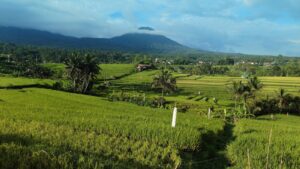Bali Then & Now: How Tourism Hotspots Are Transforming and Where to Look Next
Bali Then & Now: Evolution of Tourism Hotspots and the Rise of Nature-Led Innovation shows how Bali’s tourism landscape has shaped—and reshaped—the island’s identity. From Canggu’s rise as a remote-work mecca and Ubud’s wellness boom to Seminyak’s status plateau, familiar scenes give way to fresh frontiers: Sanur’s subtle revival, Amed’s eco-diving vibe, Lovina’s under-the-radar charm, and Sidemen’s rice-field sanctuaries. This journey highlights where culture clashes with commerce—and where nature-centered, community-driven innovation breathes new life into opportunity. Ideal for travelers, investors, and change-makers seeking to connect with Bali’s most meaningful next chapter.
Bali isn’t the same Bali you saw in travel brochures 10 or even 5 years ago. The Island of the Gods has shifted under the weight of digital nomads, Instagram-fuelled tourism, and massive lifestyle migration. Canggu has gone from sleepy rice paddies to Silicon Valley-on-Sea. Ubud has evolved from an artist’s retreat to a wellness empire. Seminyak, Sanur, and Uluwatu keep reinventing themselves. Meanwhile, East Bali and North Bali whisper promises of what Canggu once was: slow, soulful, and community-led.
This deep dive explores Bali’s then vs now story, framed through regional transformations, cultural impacts, and future opportunities. We’ll zoom in on eight regions, break it down with trend-based comparison tables, and give you visual anchors so you can literally picture the change.
🌾 1. Canggu – From Rice Fields to Remote Work Capital
Ten years ago, Canggu was a maze of green rice terraces and a handful of warungs. Today, it’s Bali’s answer to Austin, Berlin, and Byron Bay rolled into one – only with better sunsets.
| Canggu Then (2010–2015) | Canggu Now (2025) |
|---|---|
| Mainly rice fields & local banjar land | Cafés, gyms, co-working hubs, boutique villas |
| Monthly villa rent: IDR 6–10 million ($400–600) | Now IDR 25–40 million ($1,600–2,500) |
| Dirt roads, motorbikes only | Gridlocked shortcuts, “Canggu jam” daily |
| Surfers + long-stay travellers | Digital nomads, influencers, crypto expats |
Framed Highlight – Visual Cue:
A drone shot comparing Batu Bolong rice fields in 2010 vs the same view today, packed with beach clubs and scooters.
👉 Trend Insight: Canggu is proof that “hidden gems” can become saturated in under a decade. Its rise shaped Bali’s digital nomad culture but also fuelled gentrification.
🌿 2. Ubud – From Artist’s Village to Global Wellness Hub
Ubud was once an insider’s escape – rice terraces, shadow puppetry, and jungle temples. Today, it’s yoga studios, kombucha taps, and retreats marketed worldwide.
| Ubud Then (2000–2010) | Ubud Now (2025) |
|---|---|
| Cheap bungalows: $10–20/night | Luxury wellness resorts $200–500/night |
| Art galleries & Balinese dance | Yoga festivals, tantra retreats, sound healing |
| Rice farmers + expat artists | Wellness migrants, eco-investors, retreat owners |
| Village economy | Tourism-driven + rising land pressure |
Framed Highlight – Visual Cue:
Infographic of “Wellness Tourism Growth” showing yoga/wellness retreat numbers multiplying 4x from 2010–2025.
👉 Trend Insight: Ubud has commercialised spirituality, but it’s also preserved Bali’s role as a global cultural crossroads.
🌴 3. Seminyak – The OG Luxury Strip
Before Canggu, Seminyak was the playground. It shaped Bali’s reputation as a stylish, boutique escape. But as rents soared, Seminyak began aging out, losing nomads to Canggu while keeping its luxury appeal.
| Seminyak Then (2005–2015) | Seminyak Now (2025) |
|---|---|
| Cutting-edge beach clubs & villas | Slightly faded, but still luxury |
| Party capital for Aussies | Shift to mature travellers & families |
| Trendsetter | Competing with Uluwatu, Canggu |
| Villa prices booming | Plateau, with resale market growing |
Framed Highlight – Visual Cue:
A split-screen: Ku De Ta in 2007 vs Potato Head/Café scene today.
👉 Trend Insight: Seminyak is a case study in tourism lifecycle: rise, saturation, and slow repositioning.
🌊 4. Sanur – The Quiet Comeback
For years, Sanur was dubbed “the sleepy village for retirees.” But its long beach walkways, calmer vibe, and major infrastructure projects (fast ferries, toll roads, future rail links) are sparking a comeback.
| Sanur Then (2000–2018) | Sanur Now (2025) |
|---|---|
| Retiree market | Rising family & digital nomad appeal |
| Few international cafés | Growing café & coworking culture |
| Old resorts, low reinvestment | New luxury health resorts & beachfront villas |
| “Bypassed” vibe | Gateway to Nusa islands + fast ferry hub |
Framed Highlight – Visual Cue:
A rendered map of Bali showing Sanur as the “new gateway” to the Nusas and East Bali.
👉 Trend Insight: Sanur is primed for a second wave, especially for families, mid-term nomads, and slower travellers.
🌊 5. Amed & East Bali – The Next Frontier
Amed is where Bali feels like Bali 20 years ago. Fishermen’s jukungs still line the shore, and diving culture thrives. But trickles of boutique eco-resorts and creative migrants suggest the Canggu-to-Amed migration has already begun.
| Amed Then (2000–2015) | Amed Now (2025) |
|---|---|
| Fishing villages, backpacker homestays | Boutique eco-stays, digital dive nomads |
| Foreigners: mostly divers | Mix of slow travellers, retreat owners |
| Local economy: fishing + salt farming | Increasing tourism reliance |
| Dirt tracks, limited transport | New cafés, road upgrades, Wi-Fi hubs |
Framed Highlight – Visual Cue:
Contrast photo: wooden fishing boats at dawn vs modern yoga deck overlooking the sea.
👉 Trend Insight: Amed and East Bali mirror “early Canggu” – community-led, affordable, ripe for sustainable tourism if managed well.
🐬 6. Lovina & North Bali – The Untapped North
Lovina once tried to rival Kuta with its black sand beaches and dolphin tours but never quite boomed. Today, its very “underdeveloped” state makes it a fresh opportunity.
| Lovina Then (1990s–2010) | Lovina Now (2025) |
|---|---|
| Dolphin tours, budget hotels | Eco-lodges, boutique stays, small-scale tourism |
| Limited infrastructure | Slowly improving roads & Wi-Fi |
| Backpacker vibe | Attracting sustainability-minded travellers |
| Weak investment interest | Investors eyeing “last affordable coast” |
Framed Highlight – Visual Cue:
A map visual: South Bali red (crowded), North Bali green (still open for opportunity).
👉 Trend Insight: Lovina could be Bali’s “reset button” – a chance to rethink growth before overdevelopment.
🌾 7. Sidemen & Tabanan – The Last Rice Fields
Sidemen Valley and Tabanan are the lungs of Bali. Both are still deeply agricultural, though Sidemen is quietly building a rep as the slow-travel, rice-terrace escape.
| Sidemen/Tabanan Then | Sidemen/Tabanan Now |
|---|---|
| Primarily farming & ceremonies | Mix of eco-lodges + tourism |
| Rarely visited | “Secret Bali” seekers |
| Cheap land | Early eco-investor interest |
| Traditional Balinese rhythm | Under development pressure |
Framed Highlight – Visual Cue:
A cinematic aerial of Sidemen’s rice terraces with Mount Agung backdrop, framed as “The Bali That Still Exists.”
👉 Trend Insight: Sidemen & Tabanan may be Bali’s last true buffer – but only if protected from rapid gentrification.
🔮 Bali’s Future: What These Trends Tell Us
Across regions, one theme repeats: cycles of discovery, growth, saturation, and migration.
- Canggu & Ubud = Saturated.
- Seminyak = Plateau.
- Sanur = Reawakening.
- Amed/East Bali & Lovina/North Bali = Emerging.
- Sidemen/Tabanan = At a crossroads.
Framed Highlight – Visual Cue (Summary Table):
| Region | Stage | Trend | Future Outlook |
|---|---|---|---|
| Canggu | Saturated | Nomad capital, overcrowded | Spillover to Sanur & East Bali |
| Ubud | Saturated | Wellness epicentre | Remains strong but pricey |
| Seminyak | Plateau | Luxury market | May stabilise as mature hub |
| Sanur | Reawakening | Families + mid-term nomads | Strong growth potential |
| Amed/East Bali | Emerging | Slow travel, diving, eco stays | “Next Canggu” risk/opportunity |
| Lovina/North Bali | Emerging | Eco-sustainable focus | High upside if marketed right |
| Sidemen/Tabanan | Fragile | Traditional buffer zones | Critical to preserve balance |
✨ Pizza Takeaway
Bali is no longer one story – it’s many. Each region is on its own timeline of transformation, shaped by tourism, migration, and culture. Understanding the “then vs now” isn’t just travel nostalgia – it’s a roadmap for:
- Travellers seeking the Bali that fits them.
- Investors looking for the next frontier.
- Locals and policymakers working to balance growth with culture.
👉 The real question isn’t “Where is Bali going?” but rather: which Bali do you want to be part of?





